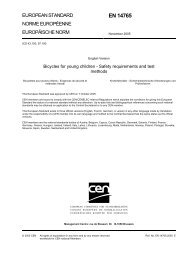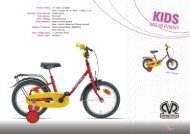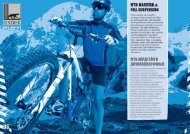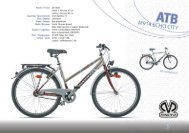EN 14766:2005 - 64_e_stf - Baltik vairas
EN 14766:2005 - 64_e_stf - Baltik vairas
EN 14766:2005 - 64_e_stf - Baltik vairas
- No tags were found...
Create successful ePaper yourself
Turn your PDF publications into a flip-book with our unique Google optimized e-Paper software.
<strong>EN</strong> <strong>14766</strong>:<strong>2005</strong> (E)For compliance with the requirements of 4.6.7.4.1, the above average values shall not exceed the relevant brakingdistances specified in Table 1.III) Ratio between wet and dry braking performanceBecause the wet and dry braking distances are measured at different test velocities, a simple comparison ofbraking distances is not meaningful. Therefore, a comparison shall be made of equivalent, calculated brakingforces, thus:The ratio between the calculated braking-force in wet conditions (F W Br max) and the calculated braking-force in dryconditions (F D Br max) measured at any operating force (F D Op) at which the dry test requirements are met shall begreater than 40 %.Based on the terminology and values of the constants as defined in 4.6.7.5.2.3 and 4.6.7.5.2.7, use the followingequation to calculate the wet and dry braking forces:F Br max = K/(D - C)Determine whether or not the requirements of the following equation have been met:F W Br max : F D Br max > 4:104.6.7.5.2 Machine test method4.6.7.5.2.1 GeneralThe test machine enables the braking distances for both brakes or the rear brake alone to be calculated frommeasurements of the individual braking forces of the front and rear brakes on a drum or belt.4.6.7.5.2.2 SymbolsF Op = Operating force (i.e. force applied on handbrake lever)F Op intend = Intended operating force (e.g. 40 N, 60 N, 80 N)F Op rec = Recorded operating force (e.g. 38 N, 61 N, 79 N)F Br = Braking forceF Br rec = Recorded braking forceF Br corr = Corrected braking force (Corrected for difference between F Op intend and F Op rec )F Br average = The arithmetic mean of the three F Br corr at one level of F Op intendF Br max = The maximum F Br averageF D Br = Dry braking-forceF W Br = Wet braking-force4.6.7.5.2.3 LinearityWhen tested by the methods described in 4.6.7.5.2.7 III a) and b), the braking force F Br average shall be linearlyproportional (within + 20 %) to the progressively increasing intended operating forces F Op intend . The requirementapplies to braking forces F Br average equal to and greater than 80 N (see Annex A).27







